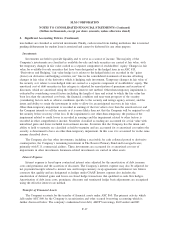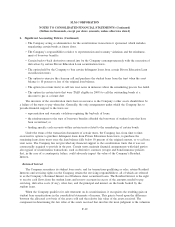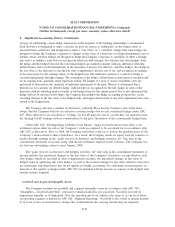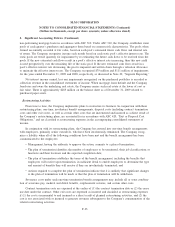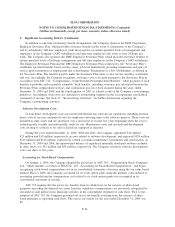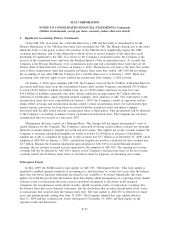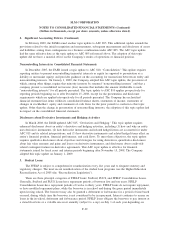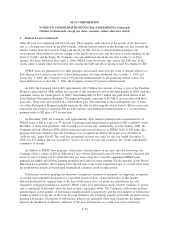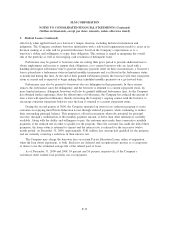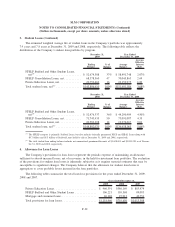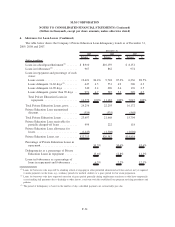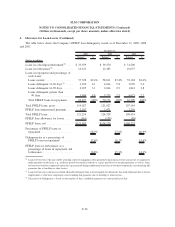Sallie Mae 2009 Annual Report Download - page 154
Download and view the complete annual report
Please find page 154 of the 2009 Sallie Mae annual report below. You can navigate through the pages in the report by either clicking on the pages listed below, or by using the keyword search tool below to find specific information within the annual report.2. Significant Accounting Policies (Continued)
Under ASC 810, if an entity has a Variable Interest in a VIE and that entity is determined to be the
Primary Beneficiary of the VIE then that entity will consolidate the VIE. The Primary Beneficiary is the entity
which has both: (1) the power to direct the activities of the VIE that most significantly impact the VIE’s
economic performance, and (2) the obligation to absorb losses or receive benefits of the entity that could
potentially be significant to the VIE. As it relates to the Company’s securitized assets, the Company is the
servicer of the securitized assets and owns the Residual Interest of the securitization trusts. As a result, the
Company is the Primary Beneficiary of its securitization trusts and will consolidate those trusts that are off-
balance sheet at their historical cost basis on January 1, 2010. The historical cost basis is the basis that would
exist if these securitization trusts had remained on balance sheet since they settled. ASC 810 did not change
the accounting of any other VIEs the Company has a variable interest in as of January 1, 2010. These new
accounting rules will also apply to new transactions entered into from January 1, 2010 forward.
On January 1, 2010, upon adopting ASC 810, the Company removed the $1.8 billion of Residual Interests
associated with these trusts from the consolidated balance sheet and the Company consolidated $35.0 billion
of assets ($32.6 billion of which are student loans, net of a $550 million allowance for loan loss) and
$34.4 billion of liabilities (primarily trust debt), which resulted in an approximate $0.7 billion after-tax
reduction of stockholders’ equity (through retained earnings). After adoption of ASC 810, with respect to the
securitization trusts that were consolidated on January 1, 2010, the Company’s results of operations will no
longer reflect servicing and securitization income related to these securitization trusts, but will instead report
interest income, provisions for loan losses associated with the securitized assets and interest expense
associated with the debt issued from the securitization trusts to third parties. This presentation will be identical
to the Company’s accounting treatment of prior on-balance securitization trusts. The Company has not had a
securitization that was treated as a sale since 2007.
Management allocates capital on a Managed Basis. This change will not impact management’s view of
capital adequacy for the Company. The Company’s unsecured revolving credit facilities contains two principal
financial covenants related to tangible net worth and net revenue. The tangible net worth covenant requires the
Company to maintain consolidated tangible net worth of at least $1.38 billion at all times. Consolidated
tangible net worth as calculated for purposes of this covenant was $3.5 billion as of December 31, 2009. Upon
adoption of ASC 810 on January 1, 2010, consolidated tangible net worth as calculated for this covenant was
$2.7 billion. Because the transition adjustment upon adoption of ASC 810 is recorded through retained
earnings, the net revenue covenant was not impacted by the adoption of ASC 810. The ongoing net revenue
covenant will not be affected by ASC 810’s impact on the Company’s securitization trusts as the net revenue
covenant treated all off-balance sheet trusts as on-balance sheet for purposes of calculating net revenue.
Subsequent Events
In May 2009, the FASB issued a topic update on ASC 855, “Subsequent Events.” This topic update is
intended to establish general standards of accounting for, and disclosure of, events that occur after the balance
sheet date but before financial statements are issued or are available to be issued. Specifically, this topic
update sets forth the period after the balance sheet date during which management of a reporting entity should
evaluate events or transactions that may occur for potential recognition or disclosure in the financial
statements, the circumstances under which an entity should recognize events or transactions occurring after
the balance sheet date in its financial statements, and the disclosures that an entity should make about events
or transactions that occurred after the balance sheet date. The topic update to ASC 855 is effective for fiscal
years and interim periods ending after June 15, 2009. The Company adopted this topic update effective
June 15, 2009 and has evaluated any events subsequent to December 31, 2009, and their impact on the
reported results and disclosures.
F-27
SLM CORPORATION
NOTES TO CONSOLIDATED FINANCIAL STATEMENTS (Continued)
(Dollars in thousands, except per share amounts, unless otherwise stated)


